|
Micscape Lite - Product Review
DNA Molecular Model Kits compared and contrasted - helices and two base pairs.
by David Walker,
UK
|
Physical molecular models have a valuable role for studying their structures. This is particularly so with DNA where photos tend to flatten the structural detail and a greater insight is also achieved by hands-on building. In a few minutes nowadays it is possible to install free molecular modeling apps for both smartphones and computers that allow complex molecules such as DNA to be downloaded and explored on
screen in 3D. It can be argued whether the same insight is gained into DNA structure when there's no sense of achievement in building or physical interaction; is software better in a complementary role?
There are a very wide range of models available from the simple showing basic helical structure and the base-pairing to more advanced examples that are built at the atomic level. As an enthusiast of physical models this review compares and contrasts eight basic types that are commonly available. It is very much a personal view but hopefully it may be of use for readers seeking one or more types perhaps for use in an educational
setting. Where a kit uses a well established maker's building system i.e Cochranes' Minit and Orbit, Molymod, ChemKits and Darling Models (Molecular Visions) only the features of the DNA kit are discussed, the systems have been reviewed in this earlier article. Prices are in the maker's home country currency.
The benefit of complementary kits: Building a larger multiple base pair DNA model with atoms/bonds is invaluable but may be less than practical in some edu' situations as they are bulky and delicate. An alternative is to assemble the start of a helix using the two base pairs of G-C and A-T to show the key details at the atomic and molecular scale, base pair structures, hydrogen bonding, sugar and phosphate
structures, anti-parallel backbones. These can then be complemented with a simpler extended helix model.
Helices built (also see the two base pair kits built below as some can be used to build helices)
|
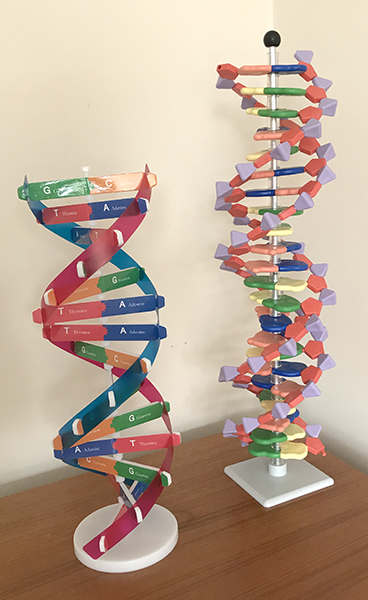 Maker - unbranded Source - e.g. eBay UK Price - typical £4-30 with shipping Height - 34 cm Maker - unbranded Source - e.g. eBay UK Price - typical £4-30 with shipping Height - 34 cm
Despite its price, this simple and cheap model made of plastic and card (model immediate right) shows some key features well; the double helix, the G-C and A-T base pairing. Also ideal for showing right handedness and can be assembled in the left handed form to show they are not equivalent. It does not show the major and minor ridges nor features at the molecular level. It is the easiest of those reviewed to show the 36° twist for each base pair
by holding a protractor on the axis. It is robust with some care in handling. Can be disassembled for storage. The model could be part built, helix split and pairs cut apart to show some basic replication concepts. Some similar kits e.g. offered on Amazon have clear not coloured plastic strip backbones.
Suggested complementary model: A smaller two base pair model illustrated below to show molecular structure of the base pairs and sugar-phosphate backbone.
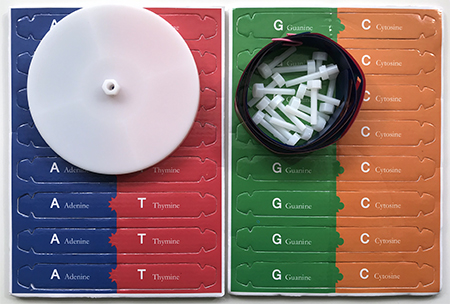
The pre-cut base pairs are made of stiff foam with card facings, the backbones are pre-notched plastic strips.
The spacers nest to form the stand.
|
|
Maker - Molymod www.molymod.com Model - Advanced miniDNA AMDNA-06-22 for 22 base pairs Source - e.g Amazon and edu' suppliers Price - typical £39-12 (inc. VAT).
Height - 47 cm Scale - ca. 1 cm = 2 Å.
The 22 base pair model was tried (image above far right), there is also a 12-layer model. The model from this well established British maker shows a number of additional key features to the simpler helix above. It is one of the clearest of those reviewed to show the major and minor grooves, more clearly perhaps than the Minit kit built to the atomic level as there are 22 rather than 15 base pairs. Some indication of the helical backbone structure
is shown from the purple tetrahedral phosphate groups and the pentagonal sugars. The base pairs have double and triple bonded hydrogen bonds but the bases are arbitrary shapes not reflecting their molecular structure. Labelling them after purchase as standard with the DynamicDNA kit below could be useful.
The kit as with all Molymod kits are presented well and supplied instruction leaflet is clear which illustrates how it can be used to demonstrate replication.
Suggested complementary model: The molecular structures of the base pairs can be illustrated by building the Molymod 'open model kit' article number MKO-ACGT-53 using the standard Molymod atomic system. See below.
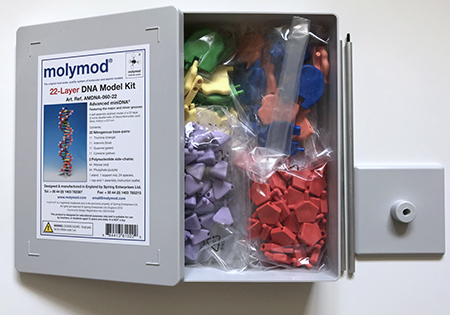 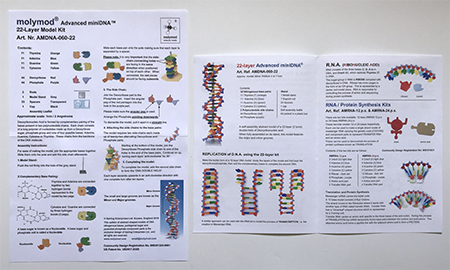 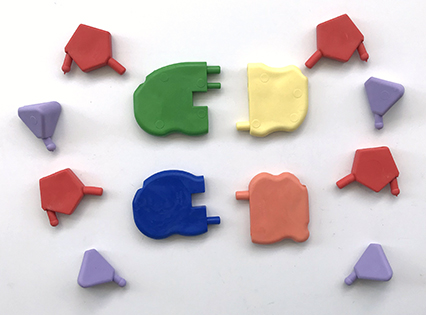
|
|
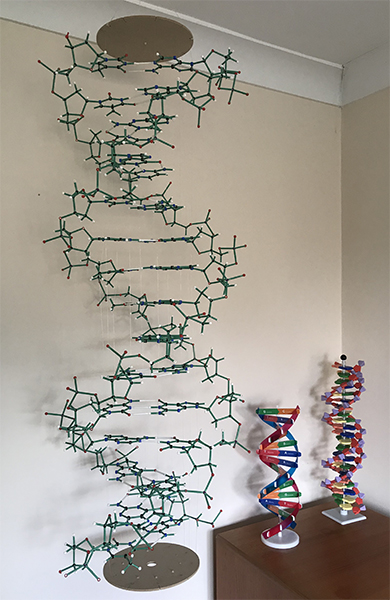 Maker - Cochranes of Oxford www.cochranes.co.uk Model Minit ProView DNA Model Kit with 15 base pairs Source - direct from Cochranes and edu' suppliers Maker - Cochranes of Oxford www.cochranes.co.uk Model Minit ProView DNA Model Kit with 15 base pairs Source - direct from Cochranes and edu' suppliers
Price - £123-20 (£147-84 inc. VAT) Height x Width - 127 x 41 cm Scale - 1Å = 2 cm
This kit has been reviewed in detail in the April 2021 issue of Micscape where assembly tips were also suggested. It is built using the maker's well established Minit system. To speed the assembly, it could be readily split into modules for a class of students (it took the author a week assigning a few hours or so a day to the build). This is the finest way of really understanding
the DNA structure; the base structures and hydrogen bond pairing, anti-parallel phosphate - sugar backbone. When built and assembled it provides a great deal of satisfaction! The string suspension system with key atoms already attached to the strings greatly eases the potentially tricky step of adding the backbones.
This is arguably best as a build once model for permanent display, the bonds loosen on reuse. On a low ceiling (as in the author's home) it occupies little room. It maybe more vulnerable in a classroom environment, the suspension system is stable but potentially vulnerable to knocks. A free standing support with storage in a side room may be one approach for safe keeping. As remarked in the intro', even a photo of a 3D model flattens the structure emphasising why hands on is so beneficial.
Cochranes also sell the kit in the larger scale Orbit system (a two base pair shown in later table). This is larger but does have a custom stand available. See the maker's website for an image of an assembled model for scale.
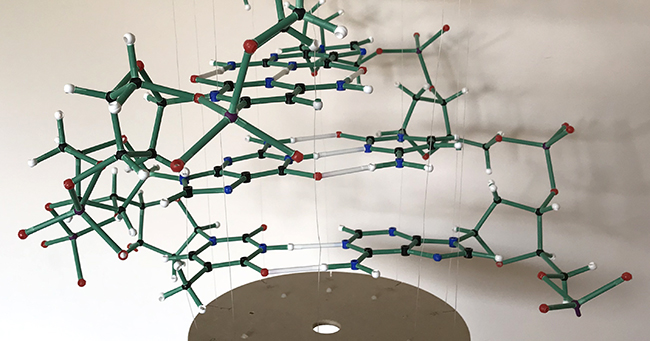
|
Two base pairs
The two red spots on the white sheet shows the width of the comparable Cochranes Minit system.
To maintain the stability and correct conformation of the backbone, the sugar to base pair bonds and those on the phosphate should not rotate. Other than the DynamicDNA model they all do to some extent. Gluing these bonds in place can help.
Note that for such short sections of the helix the 3' and 5' terminations have not been made. Partly because it makes them harder to present free standing for photography
|
Maker - ChemKits www.chemkits.com Source - maker's website Model - Organic Chemistry kits - Price - $41-99 Scale - ca. 1 inch = 1Å
This model system uses metal atom centres with coloured bonds. It also shows the Van der Waal's distances of hydrogens. A clear, open structure is achieved for this DNA model although perhaps the VDW's bond extensions may confuse the basic structure somewhat but could be snipped off. The vertical bond prongs can be used to make supports for the structure but remains quite fragile if handled. Two kits may be needed to complete as the author
has multiple kits (my first acquired in a chemistry course in the 70s, the system has a long pedigree). The separate base pair groups are quite robust for handling.
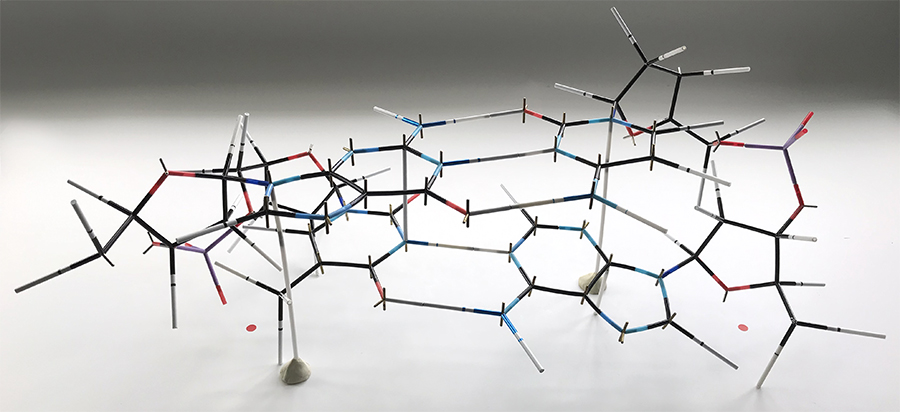
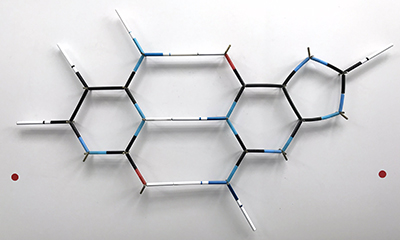 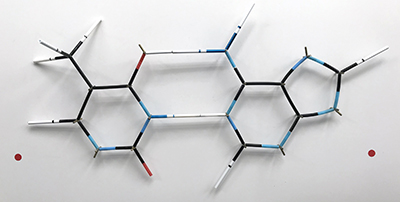 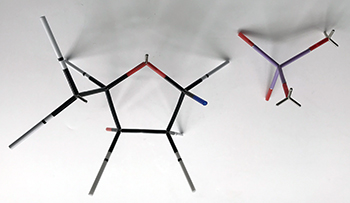
|
|
Maker - 3D Molecular Designs www.3dmoleculardesigns.com Source - maker's website, TimStar in UK Model - DynamicDNA Price - two, six and 12 base pairs: $45, $124, $237 Height - Scale - ca. 1 in 80 million stated
As the name suggests this is a dynamic model that uses an innovative combination of magnetic bonding and keyed connectors to form a model that in its 6 or 12 base pair form can be untwisted and used to illustrate replication and transcription. Of those base models built it is the most robust, maintains the base pair spacing and can be readily handled between students. The author has the two base pair kit shown below but the 12 base
pair is illustrated below courtesy of the makers.
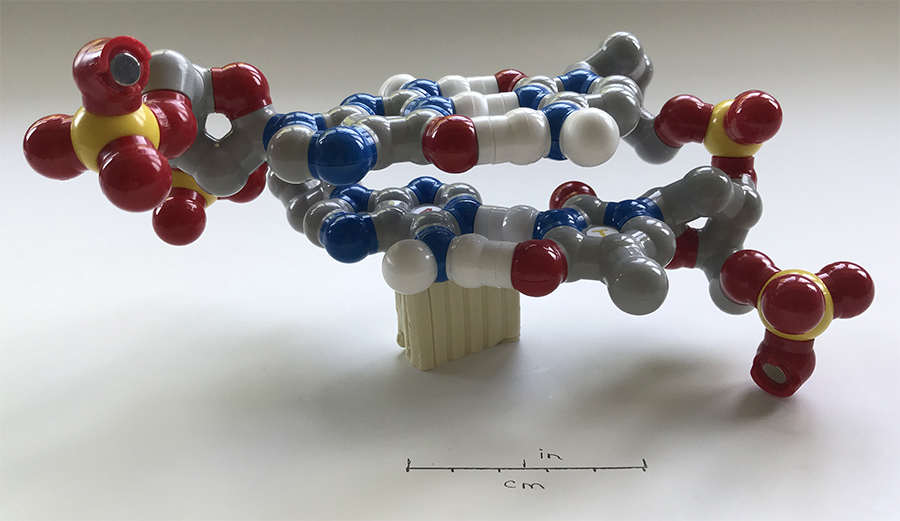 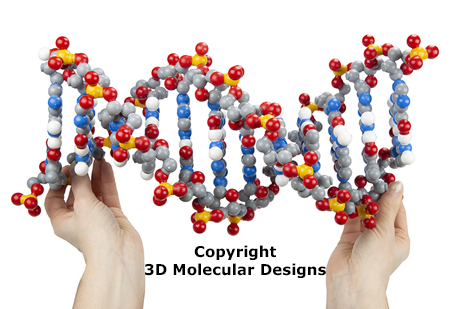
Left above: The two base pair kit built by the author.
Right above: The 12 base pair kit which includes a stand for vertical display. Photo courtesy of 3D Molecular Designs, LLC. The Dynamic DNA Kit© is manufactured by 3D Molecular Designs, in Milwaukee Wisconsin, US. It is available in the UK from Timstar Laboratory Suppliers https://timstar.com/mo190100-dynamic-dna-kit.html
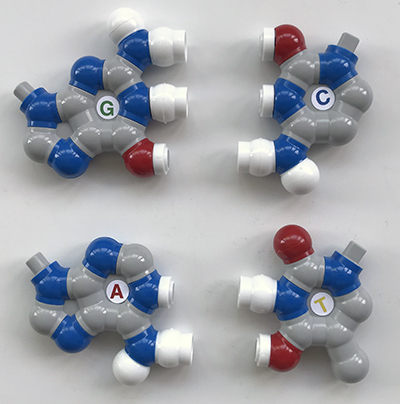 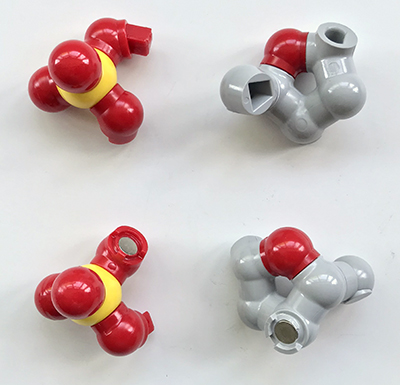
Above. The molecular structures of base pairs, sugars and phosphates are shown with atoms colour coded. Labels are provided. The correct base pairs attract via the magnets to make the bonds. 3DMolecular Designs offer invaluable, detailed Teacher's Resources describing the more extensive capabilities of the system to show
replication
and transcription.
|
|
Maker - Molecular Visions (Darling Models) www.molecularvisions.com Model /price A-T #13a and G-C #13b $4 each, sugar-phosphate #13c $2-25 Scale - 1Å = 2 inches.
This system uses coloured atom - bond integral units with atom centres built from interlocking units. This system of those tested requires the most pre-assembly familiarity with how the system works; the ball and stick systems are more intuitive. Care needs to be taken to ensure prongs and receptors of the bond connectors are in the correct places for assembly. The instruction sheet notes these but the coloured expanded view of the completed units in the extensive
booklet provided with the general kits was found
more
useful.
Base pair kits for G-C and A-T are available in this system and sugar, phosphate groups. The large scale of this system makes them ideal for demonstrations with the coloured bonds rather than atoms easier to see at distance. This kit by default shows the double bonds in the bases; this is possible with the other systems but less routine for complex molecules. However, its scale and bond flexibility makes this system the most unsuitable for showing as a part helix
of the two base pairs of the systems tried, not helped by the free rotation of the sugar and phosphate bonds in the backbones. Building a two base pair model
and devising a means to support it for a photo' was challenging using materials to hand with a cluttered result; a retort stand, coat hanger wire, cable ties, Plasticine and some computer stand base supports was the best could do!
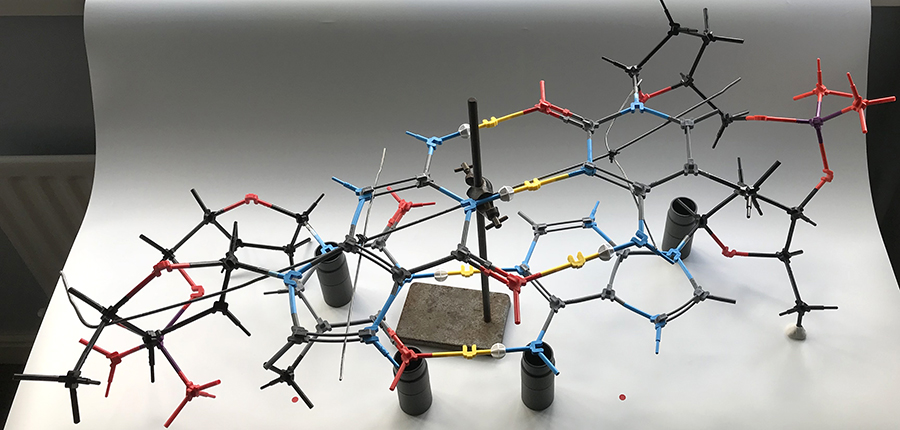
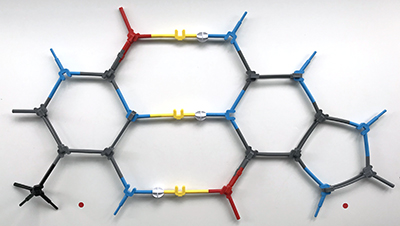 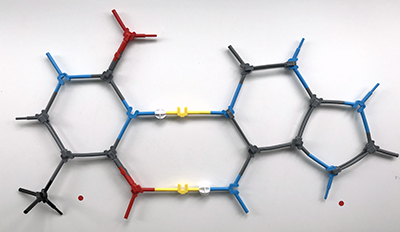 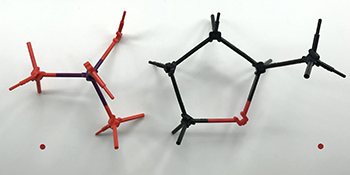
|
|
Maker - Molymod www.molymod.com Model MKO-ACGT-53 two separate base pairs, MKS-122-10 ten base pairs with stand Source - edu' suppliers two pairs, typically £19-89 exc. VAT, ten pairs £142 plus VAT. Amazon US currently stocks the 10 base pairs $230. Price - Scale - 'open / ball and stick' 1Å = 2.5 cm, 'closed / semi-space filling' 1Å = 1.5 cm
This system can be built using either short bonds to give a semi-space filling model or with longer bonds to approach a more ball and stick type. The MKO-ACGT-53 kit allows the separate two base pairs G-C and A-T to be built in open form. The various organic / biochemistry kits in the system can be used to build the backbones. The shorter bonds are more rigid and thus preferred for a two base pair part helix. Some support as shown was required for the planes not to sag and to provide some support to the backbones. To hand around the separate base pairs both bond types are suited and quite robust. The longer bonds allow the
double bonds to be shown using an sp3 atom in an sp2 role. Strained atom angles are not available so the shorter bonds are strained and tend to ping out in the five membered rings even with the special flexible 'V-link' ML-20 bonds.
The large coloured atoms give a clear indication of molecular structure.
A splendid ten base pair model MKS-122-10 with the shorter bonds is available with stand that provides the base pair support.
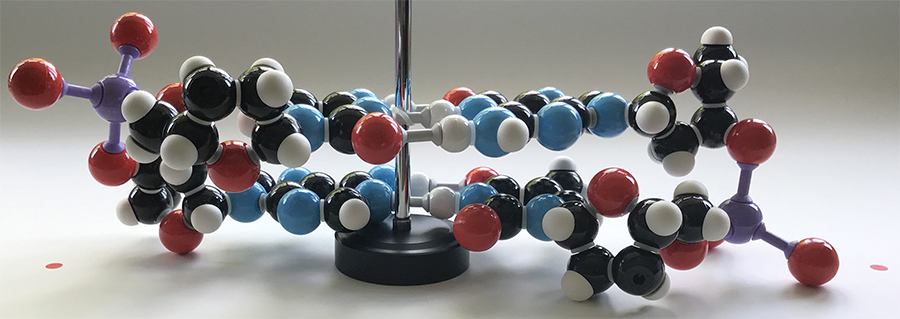
Model using the shorter bonds to give a 'closed / semi-space' filling model.
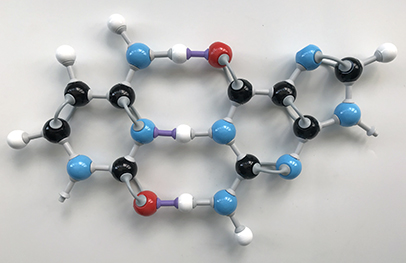 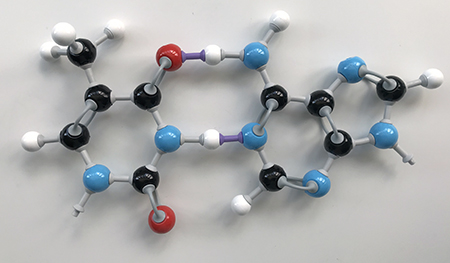
Base pairs using the longer bonds to give an 'open / ball and stick' model.
|
|
Maker - Cochranes of Oxford www.cochranes.co.uk Model Orbit ProView DNA model Kit with 15 base pairs Source - direct from Cochranes and edu' suppliers Scale - ca. 1Å = 3 cm
Price - Full 15 base pair DNA kit £130-40 (£156-48 inc. VAT). Two base pairs can use the Biochemistry Class kits £52-77 (£63-32 inc. VAT).
Like the Minit, it is a 'ball and stick' type with coloured atoms but at a larger scale. Two base pairs could be built using the Biochemistry Class kit. The molecular structure of the base pairs and sugar-phosphate backbone is clearly shown at this larger scale. The holes in the atoms are useful for supporting the two layers the correct distance apart. It is a rather delicate structure though for handling. The separate two base pairs are robust for handling and can
be separately presented and
stored. Both the Orbit and Minit systems provide carbon and nitrogen atoms of the correct angles for strained rings and each are marked.
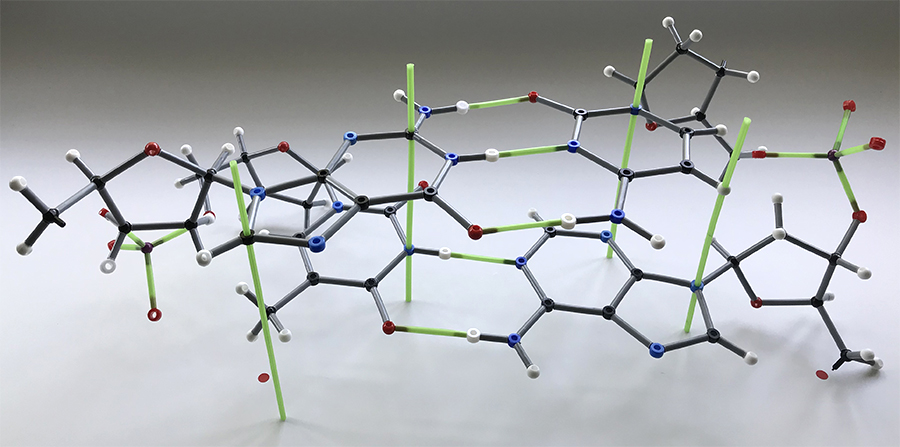
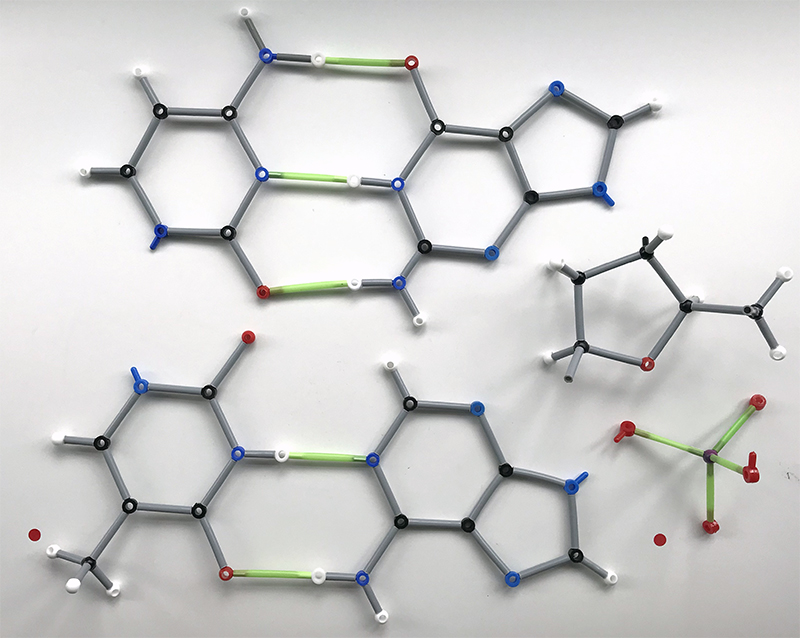
|
General observations
Each system has their pros and cons depending on what it is desired to show and if a display item to view or to be handled. The systems in the second table all show separate two base pairs well in various forms but few really succeed in offering a stable and robust two base pair helix if to be handed around. The DynamicDNA system with its rigid structure is by far the best for handling and
its unique dynamic system adds a fun factor. With care the Molymod closed molecule system is robust but does not maintain base separation and backbones can sag, their ten base pair model is offered with stand. If not being handled the Orbit, Minit and ChemKits can work well but the Molecular Designs as a two base pair helix is unsuitable even without handling.
A DNA two or more base pair model assembled using non-rigid kits is particularly dependent on good support. When molecules are built with integral 3D support as part of their molecular structure, all the kits can work very well. For example, the protein alpha helix with its helix and internal extensive hydrogen bonding in three planes have been built with the systems described and shown before in an earlier review. Molecular Visions offers an alpha protein kit (shown below) and their ice kit when built works very well.
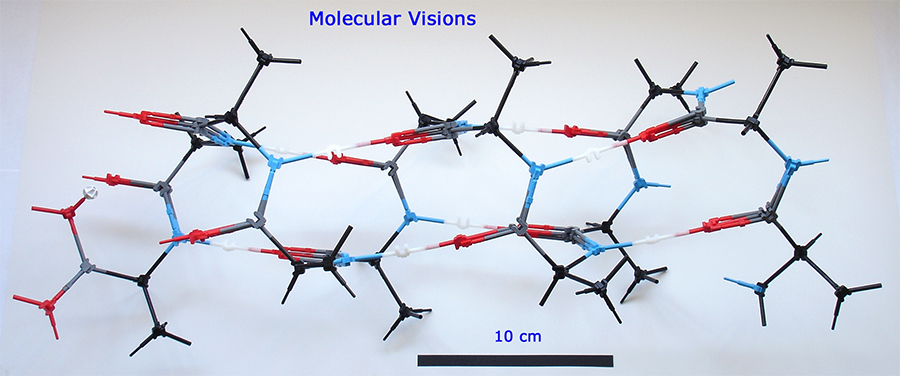
As remarked, picking two systems to complement each other can work well. If space permits and can be safely displayed the 15 base pair Minit / Orbit kits built to the molecular scale by Cochranes are very satisfying and informative.
Acknowledgements
Thank you to Diane Herman of 3D Molecular Designs for permission to use the photo of the DynamicDNA 12 base pair model.
Comments to the author David Walker are welcomed.
Other Micscape Lite molecular model articles
A comparative review of five brands of molecular model kits. With notes on the educational merits of kits in an age of software. - compares five current major brands (ChemKits, Minit, Molecular Visions (Darling Models), Molymod, Orbit) with 'Molecules in the News' in Spring 2017 supplement (heptacene, triangulene and a molecular machine (a molecular ratchet). PDFs Apr.17
Molecules in the News II - illustrated with physical molecular models. Microscopical manipulation at the limit: The six molecules which participated in the first 'Nanocar Race' on 28-29th April 2017 organised by CEMES-CNRS, France May.17
Mindfulness and molecular model making? Using models of carbon structures in the news and ice as examples Jun.17
Product Review. Cochranes of Oxford Minit Proview DNA kit Apr.21
Revision notice: Updated June 19th 2021. Some corrections, extra links and text.
©
Microscopy UK or their contributors.
Published
in the June 2021 edition of Micscape.
Please
report any Web problems or offer general comments to the
Micscape
Editor .
Micscape
is the on-line monthly magazine of the Microscopy UK web site at
Microscopy-UK
© Onview.net
Ltd, Microscopy-UK, and all contributors 1995 onwards. All rights
reserved.
Main site is at www.microscopy-uk.org.uk
with full mirror at
www.microscopy-uk.net
.
 Maker - unbranded Source - e.g. eBay UK Price - typical £4-30 with shipping Height - 34 cm
Maker - unbranded Source - e.g. eBay UK Price - typical £4-30 with shipping Height - 34 cm 



 Maker - Cochranes of Oxford www.cochranes.co.uk Model Minit ProView DNA Model Kit with 15 base pairs Source - direct from Cochranes and edu' suppliers
Maker - Cochranes of Oxford www.cochranes.co.uk Model Minit ProView DNA Model Kit with 15 base pairs Source - direct from Cochranes and edu' suppliers 

















